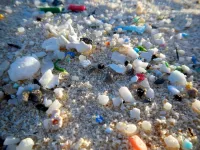(Press-News.org) CORVALLIS, Ore. - Selectively cutting trees in riparian zones to aid forest restoration can be done without adversely affecting streams' water temperature as long as the thinning isn't too intensive, new research by Oregon State University shows.
Published in PLOS One, the study led by OSU College of Agricultural Sciences graduate student David Roon is one of the few to quantify restorative thinning's effects on forest streams.
"We don't know much about what happens with the more subtle changes in shade and light that come with thinning," Roon said. "Most of the research so far has looked at the effects of clearcutting with no stream-side buffer at all, or harvests outside of an untouched buffer area. And regulatory requirements tend to look at single descriptors of stream temperature - the warmest it gets in the middle of summer, for example - and those descriptors possibly don't do a thorough job of explaining thermal influences on ecological processes."
Riparian zones - lands near streams, lakes, ponds, etc. - have unique soil and vegetation characteristics that are influenced strongly by the presence of water. Riparian zones make up less than 1% of the total area of the American West, contrast significantly with the West's arid uplands and provide habitat for a range of endangered and threatened species.
In riparian restoration, conservation managers look at an area's functional and structural elements - climate, soils, weather patterns, hydrology, plants, wildlife and socioeconomic use patterns - and actively or passively try to set in motion processes that enable natural ecological conditions to return.
Riparian forests in the Pacific Northwest, Roon explains, were "extensively altered" by previous timber harvesting practices that persisted for much of the 20th century, including clearcutting trees right up to waters' edge.
Leaving a buffer zone of vegetation alongside streams is critical for wildlife, especially salmon and trout. A riparian buffer also provides a wide array of ecosystem services for riparian forests and streams including filtering sediment and excessive nutrients and providing shade to keep water temperatures cool, as well as storing carbon. In addition, mature trees next to the stream will eventually fall in, creating important habitat for fish.
Roon and collaborators Jason Dunham and Jeremiah Groom examined the effects of riparian thinning on shade, light and stream temperature in three small watersheds in second-growth redwood forests in northern California. Dunham is an aquatic ecologist with the U.S. Geological Survey who has a courtesy appointment in OSU's Department of Fisheries and Wildlife. Groom, who holds two graduate degrees from Oregon State, operates Groom Analytics LLC, a data analysis consulting firm, and is an expert on the effects of forest harvest on stream temperatures.
Northern California is well known for its groves of large, iconic redwood trees. However, intensive logging removed most of the old-growth forests from this region and less than 10% of those forests remain.
Foresters are interested in whether thinning can be applied to young forests to help speed up the recovery of older redwood forests. Most forest restoration efforts so far have been focused on upland forests - those where soils do not stay saturated for extended periods - and have been generally successful; now attention is turning to young forests in riparian zones.
The OSU research took place both on private timber land and in nearby Redwood National Park, bringing together land managers with different natural resource management requirements with the common goal of understanding the effects of thinning on aquatic ecosystems. In this study the focus was on stream temperatures - an important consideration for the sensitive fish and amphibians that live in the watersheds in the region.
The large-scale field study enabled the scientists to measure conditions before and after experimental thinning treatments. These types of field experiments are rare in riparian forests, which are carefully protected.
"The power of these types of field experiments is that they can help us more directly attribute changes to the thinning treatment itself and remove other factors that often confound these types of studies," Roon said. "Responses to the thinning differed greatly depending on the intensity. In the watersheds where thinning treatments were more intensive, the reductions in shade and increases in light were sufficient to change the stream thermal regimes both locally and downstream. However, where the thinning treatments were less intensive, smaller reductions in shade and light resulted in minimal changes in stream temperatures."
That means, Roon said, at lower intensity levels thinning within riparian zones in second-growth redwood forests looks like a feasible restoration strategy. This study is an important step toward making robust decisions regarding whether thinning, and how much of it, can be done without having adverse effects on streams.
Future research, he added, could examine thinning treatments with a wider range of intensities. Roon also pointed out that the results were specific to the cool, coastal climates of the redwoods and would not necessarily apply to locations further inland.
"We also need to understand the effects of thinning in other locations under a range of different contexts," he said. "Until we know more about the effects of thinning on stream temperatures across a broader range of conditions, it should still be approached with caution."
INFORMATION:
Oregon State University, Green Diamond Resource Company, and Save the Redwoods League supported this research.
Around 2.5 billion years ago, our planet experienced what was possibly the greatest change in its history: According to the geological record, molecular oxygen suddenly went from nonexistent to becoming freely available everywhere. Evidence for the "great oxygenation event" (GOE) is clearly visible, for example, in banded iron formations containing oxidized iron. The GOE, of course, is what allowed oxygen-using organisms - respirators - and ultimately ourselves, to evolve. But was it indeed a "great event" in the sense that the change was radical and sudden, or were the organisms alive at the time already using free oxygen, just at lower levels?
Prof. Dan Tawfik of the Weizmann Institute of Science's Biomolecular Sciences Department explains that the dating of the GOE ...
HOUSTON - (March 1, 2021) - Rice University physicists have discovered a way to trap the world's coldest plasma in a magnetic bottle, a technological achievement that could advance research into clean energy, space weather and astrophysics.
"To understand how the solar wind interacts with the Earth, or to generate clean energy from nuclear fusion, one has to understand how plasma -- a soup of electrons and ions -- behaves in a magnetic field," said Rice Dean of Natural Sciences Tom Killian, the corresponding author of a published study about the work in Physical Review Letters.
Using laser-cooled strontium, ...
Europeans spend more than £700 billion (€800bn) a year on recreational visits to water bodies - but perceived poor water quality costs almost £90 billion (€100bn) in lost visits, a new study has found.
The new research - led by a European collaboration involving the University of Exeter and the University of Stirling - used data from 11,000 visits in 14 different countries to analyse the economic value of water bodies, such as rivers, lakes, waterfalls, beaches and seaside promenades.
The research team estimated that people spend an average of £35 (€40) travelling to and from these sites, with a typical family making 45 such trips each year.
The team also found ...
Rutgers scientists for the first time have pinpointed the sizes of microplastics from a highly urbanized estuarine and coastal system with numerous sources of fresh water, including the Hudson River and Raritan River.
Their study of tiny pieces of plastic in the Hudson-Raritan Estuary in New Jersey and New York indicates that stormwater could be an important source of the plastic pollution that plagues oceans, bays, rivers and other waters and threatens aquatic and other life.
"Stormwater, an understudied pathway for microplastics to enter waterways, had similar or higher concentrations of ...
DALLAS, March 1, 2021 — Studies representing nearly 2 million adults worldwide show that eating about five daily servings of fruits and vegetables, in which 2 are fruits and 3 are vegetables, is likely the optimal amount for a longer life, according to new research published today in the American Heart Association’s flagship journal Circulation.
Diets rich in fruits and vegetables help reduce risk for numerous chronic health conditions that are leading causes of death, including cardiovascular disease and cancer. Yet, only about one in 10 adults eat enough fruits or vegetables, according to the U.S. Centers for Disease Control and Prevention.
“While groups like the ...
A new method, described in a study published today in the journal Nature Communications, has the potential to boost international research efforts to find drugs that eradicate cancer at its source.
Most cancerous tissue consists of rapidly dividing cells with a limited capacity for self-renewal, meaning that the bulk of cells stop reproducing after a certain number of divisions. However, cancer stem cells can replicate indefinitely, fuelling long-term cancer growth and driving relapse.
Cancer stem cells that elude conventional treatments like chemotherapy are one of the reasons ...
With eight months to go before the UN Climate Change Conference (COP26), an international survey experiment has found evidence of "overwhelming" support across seven major countries for governments to "do more" to protect the environment.
The survey directly asks the public about policies they want to see backed by governments at COP26, when the UK and Italy will gather world leaders in Glasgow from 1 November to commit to urgent global climate action.
Researchers at the University of Cambridge worked with polling agency YouGov on a message-testing experiment involving 14,627 adults, with ...
Diversity, equity and inclusion (DEI) leaders in academic medicine are subject to increasing expectations with limited resources and there is an urgent need for psychiatry departments to commit to fully supporting their efforts, according to an article now available in the American Journal of Psychiatry written by top DEI leaders in academic psychiatry from across the country.
The authors, representing prominent public and private institutions, include Ayana Jordan, M.D., Ph.D., Yale University, and current APA ECP Trustee-at-Large; Ruth S. Shim, M.D., M.P.H. University ...
BINGHAMTON, NY - Several proposals have emerged on how to distribute the COVID-19 vaccine, but they fall short in ensuring that the vaccine is distributed fairly. A team including Binghamton University professor Nicole Hassoun suggests three ways to more fairly and effectively distribute the vaccine so that people in poor countries get the vaccine as soon as possible.
"Although many people in rich countries will receive a vaccine for COVID-19 this year, many people in poor countries will likely have to wait years to get one," said Hassoun. "Ethical vaccine allocation requires closing this gap and ensuring that everyone can access a vaccine ...
PHILADELPHIA-- Hospital emergency departments (EDs) not only care for patients with overdose and other complications from opioid use, but they also serve as vital touch points to engage patients into longer-term treatment. After an overdose, patients are at risk for repeat overdose and death. Pennsylvania is unique in establishing a voluntary incentive program to improve the rate at which patients with opioid use disorder receive follow-up treatment after emergency department care. Evaluations of the program show that financial incentives are effective in producing rapid treatment innovations for opioid use disorder.
In a study, researchers at the Perelman School of Medicine at ...



